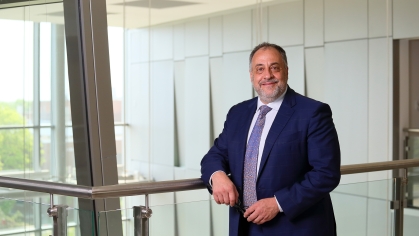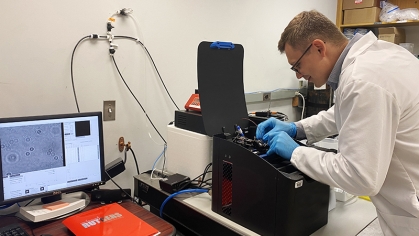SoE Partners with IEEE TryEngineering to Host NJ STEM Middle School Teachers
Teachers learn about semiconductors with a tour of the state-of-the-art Nanofabrication CORE Facility
The Semiconductor Industry Association predicts that by 2030, there will be a shortage of close to 115,000 semiconductor industry professionals. To address this challenge, the Institute of Electrical and Electronics Engineers (IEEE) TryEngineering program is helping middle school teachers introduce students to the semiconductor industry.
“America needs a sizeable workforce of semiconductor professionals. We lost the skilled workforce as semiconductor industries shifted overseas years back, but now the federal government is reshoring semiconductor manufacturing with investments from many leading companies,” says Ngwe Zin, director of the Nanofabrication Core Facility at the School of Engineering.
After visiting SoE, Zin hopes that “Teachers will be able to educate and inspire rising high school students about how semiconductors enable our modern electronics—from smart phones and computers to TVs, cars, and appliances—as well as drive economic growth and innovation,” he adds. “Not only are semiconductors essential in our daily lives , but they are also critical to our national security.”
For the second year in a row, Rutgers Engineering has hosted middle school teachers from three New Jersey Schools, where they were introduced to IEEE TryEngineering lessons about semiconductors.
“Rutgers is the flagship university of the State of New Jersey. We owe it to the public to help them understand what we do and why it is important. Partnering with IEEE TryEngineering helps the SoE build bridges to the educators who are teaching our future students,” says Department of Electrical and Computer Engineering Professor Anand Sarwate.
“He adds, “Being able to introduce ideas from the ‘E’ in STEM – engineering – can deepen student understanding and potentially spark interest in engineering as a career.”
An Immersive Tour—and More
The visiting teachers’ day began in the school’s Concept Lab, where Debra Gulick, IEEE director of Student and Academic Education Programs; IEEE Section Chair, Filomena Citerella; and Dawna Schultz, IEEE Senior STEM outreach manager led the teachers through a hands-on simulation of semiconductor manufacturing.
The tour of the SoE Nanocenter, led by Zin, was the high point of the day, according to Gulick, who notes that the group spent an hour longer than planned on the tour. Zin details how he spent time explaining the process and development of semiconductor devices used in “microelectronics, photonic, lab-on-chips, MEMS, photovoltaics, and most importantly in AI applications.”
He reports that the teachers came away with an understanding that in the AI age, “semiconductor devices are fundamental and essential building blocks. Without semiconductor devices, there will be no AI applications,” he explained.
Zin recalls that the teachers were especially interested in his explanations of how high-end, intelligent semiconductor devices were made from silicon, which is essential sand found on beaches and in the ocean.
Not only do teachers and their middle school students benefit from the IEEE TryEngineering program, but Rutgers benefits as well. As Gulick puts it, “We are delivering the message that kids should be thinking about engineering as early as middle school, not waiting until after they earn good grades in math and physics. Making a connection to Rutgers Engineering is something that the teachers will be talking about in their classrooms.”


